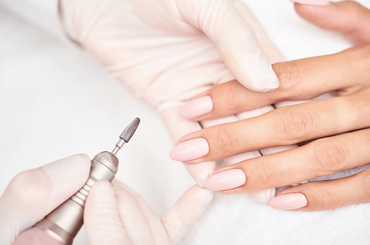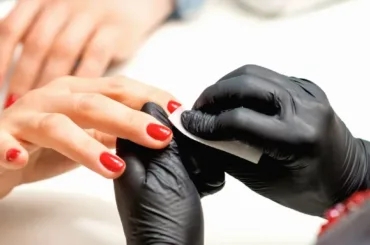With my knowledge as a nail care expert, cuticles are to be treated with utmost care to prevent infection using the right tools. Some of the tools include cuticle clippers, nippers and cuticle pushers. It doesn’t end there, however. Knowing how to use the tools is equally essential.
When using cuticle tools, avoid digging into your skin to reduce the risk of cuts, infections, and damage to live tissues. In your interest, this article will cover how to use different cuticle tools and the dos and don’t.

3 Different Cuticle Tools and How to Use Them

The following are some of the tools you can use on your cuticle and how to use them;
How to use cuticle clippers
Using nail clippers and scissors for your nails is a straightforward process that, when done correctly, contributes to neat and well-groomed nails.
Here’s a step-by-step guide:
1. Sterilize your tools
Ensure your cuticle clippers and scissors are clean and sanitized. This minimizes the risk of infection and ensures a precise cut.
2. Soften your nails
Use cuticle cream or oil on your nails to make them more pliable. If your nails are particularly hard, consider soaking them in warm, soapy water for a few minutes. This softens the nails, making them easier to trim.
3. Trim with nail clippers
Hold the cuticle clipper comfortably between your thumb and forefinger, aligning the edge with the part of the nail you intend to trim. Squeeze the clipper gently, opting for small cuts instead of attempting to trim the entire nail at once. Ensure to follow the natural curve of your nails to prevent ingrown nails.
4. Avoiding injury
Be cautious not to cut too close to the skin, as this can lead to cuts and potential infections. Trim conservatively, especially if you’re new to using nail clippers or scissors.
5. Finishing touch
After trimming, use a nail file to shape and smooth the edges. Apply a moisturizer or cuticle oil to nourish your nails and the surrounding skin.
How to use a cuticle pusher
Using a cuticle pusher is a simple yet crucial step in achieving well-groomed and healthy nails. Below is a guide to help you use a cuticle pusher effectively:
1. Preparation
Start by ensuring your hands and nails are clean. Soak your fingertips in warm, soapy water for a few minutes to soften the cuticles.
2. Choose the right cuticle pusher
Choose a cuticle pusher that suits your preference, whether it has a flat or rounded edge. Choose metal pushers for precision as they excel in areas that may be challenging to see. Their precision allows for a more thorough removal of cuticles compared to wooden alternatives.
3. Pushing back the cuticles
Find the base of your nail where the cuticle meets the nail plate, and using either the flat or curved edge of the cuticle pusher, gently push the cuticle backward in small, controlled motions. Strive for a gentle push, avoiding excessive force to prevent damage to the delicate cuticle and nail bed.
4. Be mindful of hangnails
If you notice any hangnails or bits of excess cuticle, you can carefully trim them with sanitized cuticle nippers. However, use caution to avoid over-trimming.
5. Moisturize afterward
After pushing back the cuticles, apply a cuticle oil or a nourishing moisturizer to keep the cuticles hydrated and promote healthy nail growth.
6. Clean your tools
Always clean your cuticle pusher after use to maintain hygiene. A quick wipe with rubbing alcohol or washing with soap and water is sufficient.
How to use cuticle nippers for nail
Using cuticle nippers can be a precise and effective way to manage your cuticles.
Here’s a step-by-step guide:
1. Clean your hands and cuticle clippers
Start with clean hands and nails. Soak your fingertips in warm, soapy water for a few minutes to soften the cuticles, making them easier to work with.
2. Hold the cuticle nippers comfortably
Hold the nippers between your thumb and forefinger, much like you would hold a pencil. Maintain a comfortable and steady grip. At least, a 30-45 degree angle for optimal result.
3. Identify excess cuticle areas
Examine your nails and identify any excess or overgrown cuticle areas that you want to trim. Be cautious not to cut too close to the nail bed.
4. Gently control cuts
Make gentle and controlled cuts, taking small sections at a time. This approach helps you maintain precision and reduces the risk of cutting more than intended. Carefully position the blades of the nippers at the base of the excess cuticle, ensuring you’re only trimming the dead or excess skin. Avoid cutting live tissue to prevent injury.
5. Be mindful of hangnails
If you encounter any hangnails or loose bits of skin, you can use the nippers to carefully trim them. However, exercise caution to avoid cutting healthy tissue.
6. Moisturize afterward
Once you’ve completed the trimming process, apply a nourishing cuticle oil or moisturizer. This helps hydrate the cuticles and promotes overall nail health.
7. Clean your tools
After use, clean the cuticle nippers with rubbing alcohol or wash them with soap and water. Keeping your tools clean is essential for maintaining good hygiene.
The Dos and Don’ts of How to Use Cuticle Tools
Dos
1. Soak your nails
Soak your fingertips in warm, soapy water before using cuticle tools. This softens the cuticles and makes them more pliable, reducing the risk of damage during the process.
2. Choose clean and sanitized tools
Ensure your cuticle tools are clean and sanitized before use. This helps prevent infections and ensures a hygienic nail care routine.
3. Push cuticles gently
When using a cuticle pusher, apply gentle pressure. Push the cuticles back in small, controlled motions to avoid causing damage to the delicate nail bed.
4. Prioritize hydration
Moisturize your nails and cuticles regularly, especially after using cuticle tools. This helps maintain hydration, preventing dryness and promoting healthy nail growth.
5. Clean your tools after use
After each use, clean your cuticle tools with rubbing alcohol or wash them with soap and water. This ensures that your tools remain hygienic for the next use.
6. Trim hangnails carefully
If you encounter hangnails or loose bits of skin, use cuticle nippers with caution. Trim them carefully to prevent further tearing or irritation.
Don’ts
1. Never neglect tool sanitization
Sanitizing tools is the foundation of a healthy manicure routine. Fingernail areas harbor a significant amount of harmful bacteria, making regular disinfection crucial.
2. Avoid cutting cuticles too deep
Cutting cuticles poses health risks and may lead to messy regrowth. Unprotected cuts from cuticle cutting can result in infections.
3. Don’t cut too close to the skin
Avoid cutting too close to the skin or the nail bed. This minimizes the risk of cuts, infections, and damage to live tissue.
4. Avoid rushing the process
Take your time when using cuticle tools. Rushing increases the likelihood of mistakes and injuries. A steady and patient approach yields better results.
5. Don’t overuse cuticle nippers
While cuticle nippers can be effective, avoid overusing them. Excessive trimming can lead to nail plate thinning and increased vulnerability to infections.
6. Don’t neglect moisturization
After using cuticle tools, don’t forget to moisturize. This step is necessary to avoid dry and brittle nails.
7. Avoid sharing tools
Never share your cuticle tools with others. Personal tools are for personal use to prevent the spread of infections.
8. Don’t trim live tissue
Avoid trimming live tissue, which can lead to bleeding, pain, and potential infections. Cuticle tools should only be used on dead or excess cuticles.

What does a cuticle tool do?
A cuticle tool is used for trimming, pushing back, and managing the cuticles. It aids in the removal of excess skin around the nails, promotes cleanliness and prevents potential issues such as hangnails and ingrown nails.
Summary
Using cuticle tools is essential for achieving and maintaining healthy, well-groomed nails. By understanding the purpose and techniques associated with nail clippers, scissors, cuticle pushers, and nippers, individuals can navigate a precise and safe cuticle care routine.
Also, the step-by-step guide provides a comprehensive approach, emphasizing the importance of preparation, proper technique, and aftercare. Ultimately, careful use of cuticle tools contributes to the overall health and aesthetic appeal of your nails.






